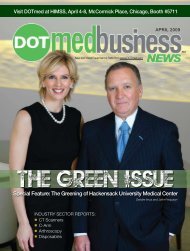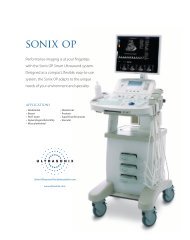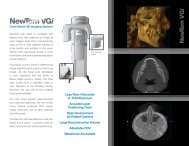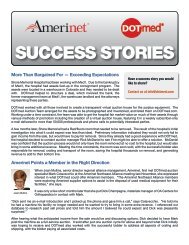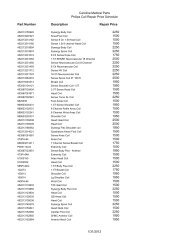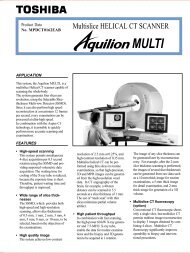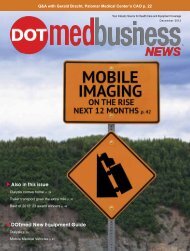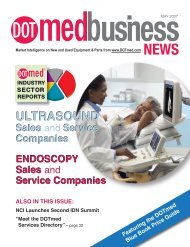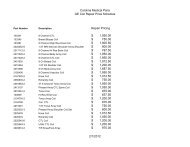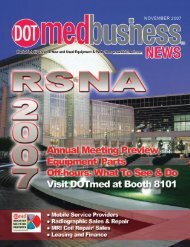I S S U E - DOTmed.com
I S S U E - DOTmed.com
I S S U E - DOTmed.com
You also want an ePaper? Increase the reach of your titles
YUMPU automatically turns print PDFs into web optimized ePapers that Google loves.
used to en<strong>com</strong>pass a broader definition of remote healthcare<br />
that does not always involve clinical services. Videoconferencing,<br />
transmission of still images, e-health including patient<br />
portals, remote monitoring of vital signs, continuing medical<br />
education and nursing call centers are all considered part of<br />
telemedicine and telehealth.”<br />
Remote care and telemedicine provide care in cases where<br />
a patient is miles away from a health care facility. In many<br />
instances, patients don’t have a way of getting to the facility<br />
for immediate help. Instead of a nurse traveling the distance<br />
to help the patient when they are in need, telemedicine and<br />
Delta Technology Res-Q-Air Waterproof<br />
Sports/Emergency Oxygen System<br />
remote care can enable the patient to get the help they need<br />
through the use of monitors and step-by-step direction. Telemedicine<br />
and telehealth allow health care providers to, on a<br />
daily basis, monitor the patient and make real-time decisions<br />
with regards to the care of their patient. Remote monitoring of<br />
ventilators, for instance, can lead to stable symptom management,<br />
improved healthy behaviors, and follow-through with<br />
treatments.<br />
By providing telemedicine, more respiratory patients will<br />
be able to receive the help and education they need in order to<br />
maintain healthier lifestyles while dealing with their disease.<br />
A more thorough integration of telemedicine and remote<br />
patient care for the future is not far on the horizon. In terms of<br />
the future of respiratory therapy, many <strong>com</strong>panies are striving<br />
to create closed-loop ventilators – ventilators that will monitor<br />
breathing and will respond automatically if a problem occurs.<br />
It is believed that new developments will be made in the future<br />
for long-term respiratory patients. “There is a greater demand<br />
for products and people to continue to improve the quality of<br />
life for long term ventilator patients in the home,” says Bill<br />
Rosas of Midwest Biomedical Recourses.<br />
Currently, the biggest challenges facing the respiratory industry<br />
are finance and economic recovery. The demand for respiratory<br />
products is very strong, yet the industry faces the issue<br />
of how customers are going to pay for equipment. The economic<br />
downturn has “made refurbished products more attractive to<br />
buyers both in the domestic and international markets,” says<br />
John Wittenberg of Inventory Solutions, Inc. He adds, “Buyers<br />
are seeing that they can get excellent quality and warranties as<br />
well as discounted prices from reputable resellers.”<br />
Judy Engle, RRT/RCPT and owner of Frontier Medical<br />
adds, “Every market is different, but the economy has slowed<br />
down and put a hold on purchasing new equipment due mostly<br />
to lack of budget.”<br />
With advancements constantly being made in respiratory<br />
technology, today’s new respiratory equipment can run anywhere<br />
from $10,000 to $14,000. In the refurbished market,<br />
equipment can be as much as 50% less expensive. John Wittenberg<br />
says, “The main thing is that the refurbished equipment<br />
industry is be<strong>com</strong>ing more mature; people know they can<br />
get really high quality equipment that <strong>com</strong>es with paperwork<br />
indicating it will last. It changes the face of the industry.”<br />
Inventory Solutions, Inc. specializes in the sale of refurbished<br />
respiratory equipment like ventilators, Pulse Oximeters,<br />
Sleep Products, Concentrators, Patient Monitors, Phototherapy,<br />
Apnea Monitors and Liquid Oxygen. He adds, “We<br />
don’t look at one particular product selling. If someone needs<br />
something, we want to have it patient-ready and on the shelf in<br />
order to get our product to them quickly.”<br />
It seems that despite the downward turn of the economy,<br />
the respiratory equipment sector is doing well. However, as a<br />
result of Medicare/Medicaid reimbursement cutbacks and adjustments,<br />
changes will occur. Ken Johnston told <strong>DOTmed</strong>,<br />
“Right now, in home oxygen delivery, reimbursement systems<br />
in Medicare/Medicaid are about $140 plus per month and $70<br />
per month for portable oxygen.”<br />
The LTV 1200 from CareFusion;<br />
critical care anywhere<br />
<strong>DOTmed</strong>business news I s e p t e m b e r 2009 39



